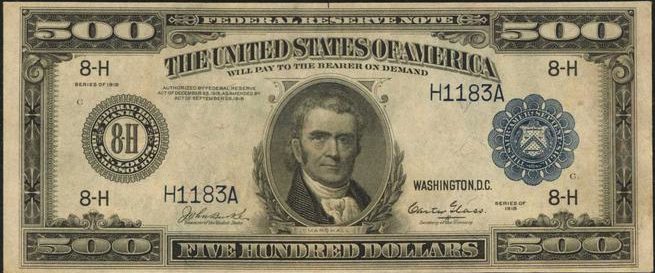Value of Series of 1918 Five Hundred Dollar Blue Seal Federal Reserve Note
| Year: 1918 (September 26 1918) | Type: Federal Reserve Note | Denomination: Five Hundred Dollar Bill |
| Value: The value of $500 1918 federal reserve notes is based on condition, serial number, and bank of issue. | ||
| We purchase $500 bills from from 1918. Send us an email to tell us what you have admin@oldcurrencyvalues.com. We will respond quickly with our opinion and offer. | ||
| Description: I consider the 1918 $500 Federal Reserve note to be the ultimate note for a lawyer. It is a tremendous show piece. It features a portrait of perhaps the most important lawyer ever, John Marshall. Marshall was the Chief Justice of The United States from 1801 until 1835.
1918 $500 notes have a blue seal and serial number. The year 1913 is also printed on these, but that year does not matter. This $500 note is considered the most available and affordable large size five hundred dollar note. It can be bought in circulated condition for as little as a few thousand dollars. Nice looking examples will be worth more. Condition, serial number, and issuing district are always important. If you have a note as seen below, please tell us about it. We are interested buyers.
|
||
| Variations: All twelve federal reserve banks issued 1918 five hundred dollar notes. Four of the districts issued two different varieties. In total there are 16 different 1918 $500 bill types. Some of these are extremely rare, and the rest are just rare. Contact us for exact pricing. | ||
| Inscriptions: Federal Reserve Note – Series of 1918 – Authorized by Federal Reserve Act of December 23, 1913 As Amended By Act of September 26, 1918 – The United States Will Pay To The Bearer On Demand Five Hundred Dollars – Washington D.C. – Register Of The Treasury – Treasurer Of The United States – Amer Septent Sigil Thesaur – This note is receivable by all national and member banks and federal reserve banks for all taxes, customs and other public dues, it is redeemable in gold on demand at the treasury department of the United States in the city of Washington, District of Columbia, or in gold or lawful money at any federal reserve bank. | ||

